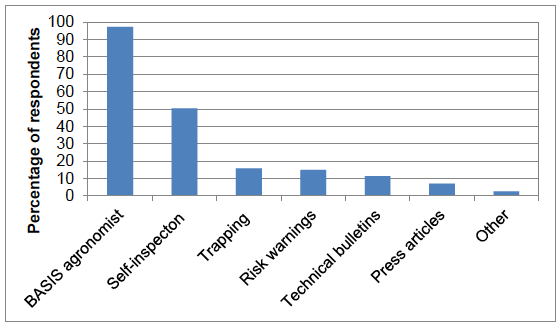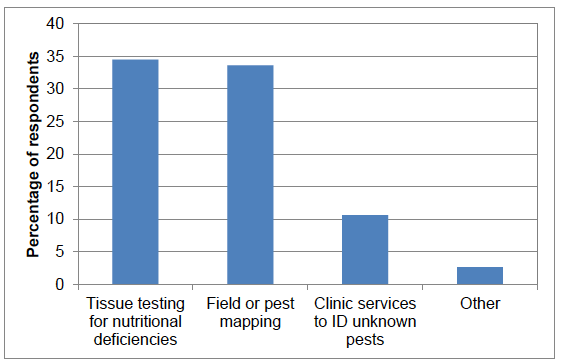Pesticide usage in Scotland: arable crops and potato stores 2016
This publication presents information from a survey of pesticide use on arable crops and potato stores in Scotland during 2016.
This document is part of a collection
Table 53 Summary of responses to pest monitoring questions - 2016
| Pest monitoring activity |
Percentage yes response |
|---|---|
| Setting action thresholds for crops |
68 |
| Monitor and identify pests |
100 |
| Use of specialist diagnostics |
58 |
| Regular monitoring of crop growth stage |
99 |
| Any pest monitoring activity |
100 |
Figure 64 Methods of monitoring and identifying pests (percentage of respondents) - 2016

Note: 'other' includes information from local farmers and growers
Figure 65 Use of specialist diagnostics (percentage of respondents) - 2016

Note: 'other' includes using nitrogen sensor for variable rate application and using applications on phone
Pest control
If monitoring, identification, and action thresholds indicate that pest control is required, and preventive methods are no longer effective or available, IPM programs evaluate the best control method in relation to effectiveness and risk. Control programmes incorporate non-chemical methods alongside, or instead of, chemical control. Use of chemical pest control should be as targeted as possible and the risk of resistance development should be minimised. The effectiveness of the control programme should be reviewed regularly to gauge success and improve their regime as necessary. Table 54 presents an overview of the pest control measures reported by the farmers surveyed. All of the growers sampled adopted at least one IPM pest control activity.
Sixty eight per cent of farmers reported that they used non-chemical control in partnership or instead of chemical control. The majority of farmers used hand rogueing as part of their weed control measures (65 per cent). Of these farmers, 91 per cent were using hand rogueing to control wild oats. Some growers also used mechanical/manual weeding or pest trapping ( Figure 66).
Seventy three per cent of farmers stated that they targeted their pesticide applications using monitoring data. The most common method reported was spot treatments, used by 48 per cent of farmers ( Figure 67). Spot treatments were used to combat weeds including docks, wild oats and couch. Thirty per cent reduced their dosage or frequency of applications where possible and 25 per cent used drift reduction. In addition, 73 per cent of farmers stated that they followed anti-resistance strategies. These included 57 per cent minimising the number of applications, 34 per cent using pesticides with multiple modes of action and 27 per cent using pesticides with multi-site modes of action ( Figure 68).
All respondents stated that they monitored the success of their crop protection measures. The measures used included 91 per cent having a regular review with their agronomist, 39 per cent investigating causes of poor efficacy, 35 per cent conducting regular self-inspection and 16 per cent having a seasonal review of practice ( Figure 69).
Contact
There is a problem
Thanks for your feedback